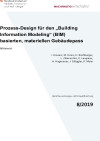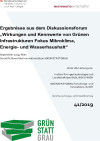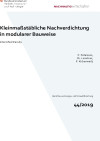Suchergebnisse
SeasonalGridStorage - Innovative saisonale Wärmespeicher für urbane Wärmenetze

In diesem Projekt wurden Konzepte zur Nutzung innovativer Speichertechnologien, wie thermochemische Speicher (TCS) mit hohen Energiedichten und der Möglichkeit der druck- und verlustlosen Speicherung entwickelt und mit Hilfe von Simulationsrechnungen in technischer, ökologischer und wirtschaftlicher Hinsicht untersucht sowie rechtliche Randbedingungen bewertet.
Schriftenreihe
21/2018
M. Köfinger, D. Basciotti, D. Lager, O. Terreros, C. Zauner, H. Böhm, J. Lindorfer, R. Tichler, A. Zauner
Herausgeber: BMIT
Deutsch, 151 Seiten
Downloads zur Publikation
Tage des Passivhauses 2018
09. - 11. November 2018
österreichweit, AT
In Österreich werden 130 Passivhäuser ihre Türen zur Besichtigung öffnen. Diese Einblicke in die Zukunft des Wohnens machen schnell deutlich: Ein Passivhaus spart nicht nur Kosten vom ersten Tag an. Zu den größten Vorteilen der energieeffizienten Bauweise zählt der hohe Komfort und gute Luftqualität.
M-DAB2: Material intensity of inner development - resource assessment and localization of urban development potentials
For the first time, the material intensity of inner development (in terms of material quantities) for different design variants was considered in the evaluation of inner development potentials. A set of methods for the holistic evaluation of potential areas and different development variants and scenarios for resource-saving inner development was created.
Programmevaluierung "Stadt der Zukunft" 2013 - 2021
Im Rahmen dieser Evaluierung wurde überprüft, welche Wirkungen das Programm "Stadt der Zukunft" seit seiner Einführung erzielen konnte. Die Basis dafür bilden umfangreiche Befragungen von Projektnehmer:innen aus der Forschung und Multiplikatoren und Multiplikatorinnen aus Anwendungsgebieten wie der Ziviltechnik und Stadtplanung. Die Evaluierung schafft damit eine wichtige Grundlage für die Gestaltung von zukünftigen Forschungsförderungen.
FIT4UrbanMission: Klimaneutrale Städte und Gemeinden
Neun der größten österreichischen Städte machten sich 2020 im Rahmen der Initiative "FIT4UrbanMission" gemeinsam auf den Weg, klimaneutral zu werden. In den Städteporträts verraten diese, welchen Schwerpunkt sie in Sachen Klimaneutralität für ihre Stadt setzen wollen und welchen speziellen Herausforderungen sie sich dabei stellen müssen.
Highlights der Bioenergieforschung 2023
19. Jänner 2023, 9:00 - 15:00 Uhr
Messe Congress Graz, Steiermark Messeplatz 1, 8010 Graz
Aktuelle Entwicklungen und Ergebnisse aus den IEA Bioenergy Tasks sowie transnationale Forschungs- und Entwicklungsprojekte zur nachhaltigen Nutzung von Bioenergie aus dem ERA-NET Bioenergy wurden im Rahmen der Mitteleuropäischen Biomassekonferenz CEBC 2023 vorgestellt.
3Sat Dokumentation zu urbaner Überhitzung mit Projekten aus Stadt der Zukunft
3Sat beleuchtet in der Dokumentation „Heißes Pflaster Stadt - Warum wir mehr Pflanzen brauchen“ Maßnahmen gegen urbane Überhitzung und nimmt dabei Bezug auf Stadt der Zukunft-Projekte. Die Erstausstrahlung erfolgte am 12.12.2018 um 20.15 Uhr.
Workshop Digitale Energieplanung
29. Jänner 2019, 10:00 bis 16:00
Wien
Gestalten Sie die Zukunft der digitalen Energieplanung in Österreich aktiv mit! Schwerpunkte sind Datenformate, Werkzeuge und Prozesse für DIM-basierte Energieplanung sowie innovative DIM-basierte Anwendungen im Bereich Energie.
Prozess-Design für den „Building Information Modeling“ (BIM) basierten, materiellen Gebäudepass BIMaterial

Generierung des materiellen Gebäudepass (MGP) - Dokumentation der materiellen Zusammensetzung eines Bauwerkes, die quantitative und qualitative Auskunft über die relevanten Rohstoffe in einem Bauwerk gibt. Als Information und Datenbasis für das MGP wurde die Building Information Modelling Methode und ein digitales Gebäudemodell verwendet. Als Ergebnis wurde ein Pflichtenheft für eine BIM-basierte MGP App geschaffen werden.
Schriftenreihe
8/2019
I.Kovacic, M. Honic, H. Rechberger,L.Oberwinter, K. Lengauer,A.Hagenauer, J. Glöggler, K. Meier
Herausgeber: BMVIT
Deutsch, 48 Seiten
Downloads zur Publikation
Austrian Climate Research Programme
Mit dem Förderprogramm des Klima- und Energiefonds werden Forschungsprojekte unterstützt, die sich mit den Auswirkungen des Klimawandels und den notwendigen Anpassungsmaßnahmen beschäftigen. Der ACRP-Call liefert somit wissenschaftliche Grundlagen für die Implementierung der Klima- und Energiestrategie #mission2030 der österreichischen Bundesregierung und die Umsetzung des Pariser Klimaabkommens.
Ergebnisse aus dem Diskussionsforum „Wirkungen und Kennwerte von Grünen Infrastrukturen Fokus Mikroklima, Energie- und Wasserhaushalt“

Grüne Infrastrukturen und naturbasierte Lösungen leisten einen wesentlichen Beitrag zur Anpassung urbaner Räume an den Klimawandel. Beim Diskussionsforum im Sommer 2019 wurden Wirkungen und Kennwerte von Grünen Infrastrukturen diskutiert.
Schriftenreihe
41/2019
R. Stangl, U. Pitha, B. Scharf, S. Formanek, V. Enzi
Herausgeber: BMVIT
Deutsch, 17 Seiten
Downloads zur Publikation
Kleinmaßstäbliche Nachverdichtung in modularer Bauweise (Intensified Density)

„Intensified Density“ hat untersucht, ob eine kleinmaßstäbliche Verdichtungsstrategie für die Vorstädte / Zwischenstädte mittels einer modularen Bauweise eine konkurrenzfähige Alternative sowohl zu den sich ausbreitenden Einfamilienhaussiedlungen als auch zu Großprojekten darstellen kann, bei Nutzung von vorhandener Infrastruktur.
Schriftenreihe
44/2019
P. Petersson, Ch. Linortner, P. Kickenweitz
Herausgeber: BMVIT
Deutsch, 72 Seiten
Downloads zur Publikation
Webinar Energiewende: Forschung, Innovation und Marktentwicklung 2019
8. Juli 2020
Online
Drei Studien zu Energieforschungsausgaben, Marktentwicklungen der Energietechnologien sowie Green-Tech-Innovationscluster in Österreich, die im Auftrag des BMK erstellt wurden, wurden präsentiert. Über 200 VertreterInnen aus Wirtschaft und Wissenschaft sowie Interessierte nahmen teil.
IEA SHC Conference and ISES Solar World Congress 2017
29. October - 2. November 2017
Jumeirah Hotel at Etihad Towers, Abu Dhabi, United Arab Emirates (UAE)
The International Solar Energy Society, ISES, and the International Energy Agency’s Solar Heating and Cooling Programme, IEA SHC, are very pleased to announce that their next international conferences, the ISES Solar World Congress 2017 (SWC 2017) and the Solar Heating and Cooling for Buildings and Industry Conference (SHC 2017) will be held together.
Tage des Passivhauses 2017
10. - 12. November 2017
Österreichweit, AT
Eine Gelegenheit weltweit Passivhäuser zu besichtigen. Besuchen Sie ein Passivhaus in Ihrer Nähe und lernen Sie aus den Erfahrungen der Bewohner.
Städtebauliche Exkursion "Amsterdam - Almere - Bottrop - Hamburg"
Mehr als 20 Experten und Expertinnen besuchten im Zuge einer städtebaulichen Exkursion, organisiert von der TU Graz im Auftrag des BMVIT (heute BMK), die städtebaulichen Hotspots Amsterdam, Almere, Bottrop und Hamburg.
Blockchain REAL
9. März 2018
Seifenfabrik, Angerergasse 41-43, A-8010 Graz, AT
Die Blockchain lässt im Moment wie keine andere Technologie neue Märkte und Geschäftsmodelle entstehen. Blockchain REAL zeigt Visionen, woran Andere arbeiten und was schon heute in die Realität umgesetzt wird. Start-ups können mit Investoren, Business Angels und Immobilienexperten in Kontakt treten.
New European Bauhaus - Jour Fixe Österreich
30. November 2023
Architekturzentrum Wien (AzW)
Im Fokus der Veranstaltung stand der Austausch zu nationalen NEB Aktivitäten und Positionen sowie die Vernetzung der Teilnehmer:innen. Der informelle Austausch im Rahmen der New European Bauhaus Initiative hatte zum Ziel, das Netzwerk und den Erfahrungsaustausch zu fördern.
Workshopreihe „Kreislauffähiges Planen und Bauen“
23. April - 16. Mai 2024
Online & Präsenz (Wien)
Die Workshopreihe bietet in vier Modulen einen umfassenden Überblick über alle Aspekte der Kreislauffähigkeit.
IEA Vernetzungstreffen 2017: Die Transformation des Energiesystems als sozial-ökologische Aufgabe
12. - 13. Oktober 2017
Literaturhaus Salzburg, Strubergasse 23, H.C. Artmann-Platz & Kolpinghaus Salzburg/Eco-Suite Hotel, Adolf-Kolping-Strasse 10-12, 5020 Salzburg
Das IEA Vernetzungstreffen wurde heuer als eineinhalb-tägige Veranstaltung mit Besichtigungstouren in Salzburg organisiert. Thema war die Transformation des Energiesystems. Es standen Updates und Ergebnisse aus den Annexen und Tasks der IEA Forschungskooperation am Programm.
